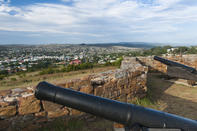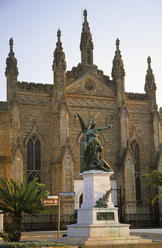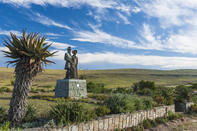First Inhabitants
A long time before the Europeans and the Xhosas first made contact, the Khoi and San people moved through Makhanda. You can honour the Khoi people if you happen to spot the Pleiades.

This cluster of seven stars was viewed by them as the rain stars. They would dance, sing and meditate at each appearance. The rising of the Pleiades, in fact, marks the beginning of the year in Africa. During June, young Xhosa initiates return from the period of isolation during their transition from boyhood to manhood.
You may notice initiates daubed from head to toe in white clay during mid-winter and during the summer holidays. Makhanda as a formal city was founded by Colonel John Graham in 1812 as a military garrison during the period of the Frontier Wars.
Battle of Grahamstown

When Dutch-descended trekboers arrived in the Eastern Cape via the Little Karoo and Langkloof in the mid-1700s, there was, at first, enough land and tolerance between them and the pastoral Xhosa. However, varying attitudes to land ownership, spiritual beliefs and a lack of cultural empathy eventually led to friction and the first of eight frontier wars erupted.
Basically, the settlers wanted land and the Xhosa sought to protect their pastoral and pagan way of life. When the British army arrived on the scene in the early 1800s, the conflict escalated. In 1812 Colonel Graham was sent to establish a line of forts along the Great Fish River, with his headquarters at Fort Graham.
He then set about brutally pushing the Xhosa people back over the Fish river. In 1819 the Xhosa military leader and prophet Nxele, also known as Makana, united many tribes for an attack on Fort Graham, but it failed in the face of British fire power. As a result of this battle it was decided to settle 4 000 Britons in the area to consolidate British occupation of the territory. Makana and other Xhosa leaders were tried and banished to the Cape, eventually landing up on Robben Island.
Makana drowned in the waves off Bloubergstrand while helping other prisoners escape. Many historians consider this to be the most important battle in the history of South Africa, but the Eastern Cape Frontier Wars continued into the 1860s.
Other Interesting Facts

The 1820 settlers arrived in Grahamstown, now called Makhanda and many worked as artisans and craftsmen in what grew to become a market town. This resulted in demand for educational establishments and churches. Makhanda was once the largest city in South Africa after Cape Town and was the first town established by the British in South Africa.
The South African parliament sat in Grahamstown in 1864. South Africa’s first identified diamond, The Eureka, was authenticated in 1867 at Grahamstown. In commemoration of the soldiers that died during the South African War, author Rudyard Kipling wrote the inscription for the angel statue situated at High Street. In 2013 the oldest fossil land animal from the Gondwana supercontinent was discovered near Makhanda and represents a new species of scorpion from 360 million years ago even before the era of the dinosaurs.
By David Bristow